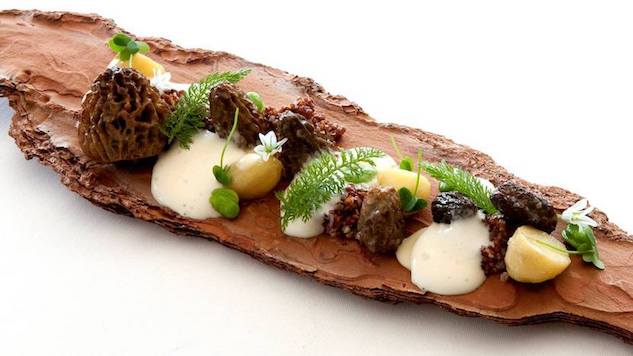Jet Set Bohemian: Flavors of the Forest

As a series of amuse-bouches were placed on our table, I wasn’t sure which part was actually edible and which was just there for display. Pancetta snaked its way around wild salsify, a root vegetable shaped as a twig, sitting on a bed of pine leaves. Kohlrabi, a bulb-like vegetable that’s part of the cabbage family, was molded into a cone and stuffed with parsley, placed delicately over moss and bark. Chicken consommé, meanwhile, was served with fried pieces of chicken perched in a nest complete with feathers. This was just the start to a 12-course tasting at the two Michelin-starred restaurant Mirazur, a Menton, France-based eatery known for weaving in elements of the nearby mountains and sea. It’s inventive plates like these that have earned the 40-year-old, Argentinian-born chef Mauro Colagreco titles like Gault & Millau’s “Chef of the Year,” making him the first non-French chef to win the award.
The chef sources his seafood from the bay sitting below the three-level, 1930s rotunda-style restaurant, which is surrounded by a vegetable garden growing seasonal fruit, more than 250 herbs and flowers, and avocados from a 200-year-old tree. Mirazur reopened last month for its 11th season, and while Colagreco relies on flavors from the rich regions of the Côte d’Azur and Ligurian Coast of Italy, he also pulls inspiration from nature with both his garnishing and forest-themed fare.
 Photo courtesy of Mirazur’s Facebook
Photo courtesy of Mirazur’s Facebook
Mixologists and chefs like Colagreco are turning to the surrounding forests for inspiration and ingredients, redefining what it means to serve seasonable and sustainable cuisine using birch-infused syrups as bases for cocktails and wild herbs and foraged mushrooms in sauces.
At the award-winning A21 Decades, a cocktail bar housed in a former sex shop in the center of Helsinki, owner Timo Siitonen looks to Finnish flavors when crafting his nature-based libations. Playing on local culture and seasons, A21 Decades takes traditional cocktails and gives them a Nordic twist. The Koivu 3.0, for example, is inspired by the iconic tree of Finnish forests—birch—which is crafted into a syrup serving as the cocktail’s base. Classics like Sex on the Beach have been renamed Sex in the Forest and weave in herbal and floral notes from ingredients like thyme liqueur, cranberry black tea and blueberries. Of course Old Fashions also take a cue from Nordic culture, throwing in sought-after orange-tinged cloudberries that are such a delicacy in the region, they’re nicknamed “highland gold.”
 Photo courtesy of A21 Decade’s Facebook
Photo courtesy of A21 Decade’s Facebook
 Photo courtesy of IDES
Photo courtesy of IDES